How To Prevent Dust In Your Home Before It Forms
Learn how to reduce dust in your home with these expert tips.

Getty Images/KatarzynaBialasiewicz
Dust is a pesky household issue that can often creep up if not maintained. If you hate dealing with dust bunnies around your home every few weeks, there are ways to prevent dust before it forms. Below, cleaning expert Sabrina Fierman explains the best weekly and monthly practices for preventing dust in your house.
How To Prevent Dust from Forming
“It’s a Sisyphean task to keep dust out of our homes, but we can manage the dust so as to minimize its accumulation and circulation within the home,” explains Fierman. You can use HEPA filter air purifiers to prevent dust from developing in your house. Replace or clean the filter per the manufacturer’s recommendation. HEPA filters are great for removing dust and other particles from the air. “I would say this is a non-negotiable item for anyone with respiratory issues,” suggests Fierman.
Use a HEPA filter vacuum weekly at a minimum, and up to 3-4 times per week depending on traffic in the home—make sure to replace vacuum bags as needed. “A full vacuum bag will not only hinder its effectiveness, but it also will not allow the engine to work properly and will eventually damage the engine,” explains Fierman.
For pet owners, brush pets regularly outdoors. “Especially for pets that shed (most pets), groom them regularly outdoors,” says Fierman. “This will greatly reduce the amount of hair and dander in the home, which carry allergens and create environments for dust and mites to collect.”
Fierman also suggests eliminating carpeting or using only low-pile carpets. Unfortunately, textiles in general are great dust collectors. “The fewer textiles in your home the better,” says Fierman. “Consider wooden Venetian blinds in lieu of drapes, wood flooring in lieu of carpets, and leather furniture when possible.”
Another interesting tactic Fierman suggests is to run a humidifier in your home. While a humidifier won’t actually reduce the amount of dust in your home, it causes the dust to cling together, which weighs it down and makes the particles heavier and less efficient at traveling through the air, according to Fierman.
Keep closet floors clear and vacuum them regularly. “Closet floors are easily forgotten spaces, and they need to be vacuumed and dusted, too,” explains Fierman. “It’s also a good idea to wash your bedding weekly—pillows can also go through the dryer cycle, which will remove any dust and kill mites.”
It’s a good idea to try and reduce clutter in your home. The more objects you have in the home, the harder it is to dust because there are so many more places for dust to accumulate and hide. Plus, dusting is harder because more things have to be moved around, explains Fierman.
Finally, Fierman warns against using old-fashioned feather dusters. “They are cute, but they merely push dust around and launch it back into the air,” she says. “Try something like a Swiffer duster—they are designed to actually trap dust, unlike traditional dusters.”
How To Keep Dust Outside
First of all, you want to keep your windows closed as much as possible. “Most dust (particularly in cities) comes from outside the home,” explains Fierman. “Also, make sure to keep air conditioner filters clean, and wash AC filters before and after each summer season.”
Be sure to keep HVAC systems clean, too. “HVAC systems need a professional cleaning once every 3-5 years, unless smokers occupy the home, pets that shed, or there has been adjacent or internal construction,” says Fierman.
Another smart idea to prevent dust before it forms is to have a no-shoe policy in your home. Not only does this reduce dust and dirt, but it also reduces pathogens and lead coming into the home. “For any home with infants and toddlers, this should be non-negotiable,” warns Fierman.
For city dwellers, keep informed of any adjacent construction projects and speak with your building’s management to make sure that contractors have properly sealed up vents. “If you share any walls with adjacent construction, know that dust can seep in through cracks in the walls,” says Fierman.
How To Deal with Dust from Pets
To prevent your pet from bringing dust indoors, Fierman suggests two things. First, make sure you groom your pets regularly, and outdoors whenever possible. Secondly, if you have a city pet, have pet wipes handy at the front door to clean their feet before coming into the home.
What Not To Do When Trying To Prevent Dust
According to Fierman, there are three things you should definitely not do when trying to prevent dust before it forms. “Don’t shake out blankets and textiles in your home (do this outside instead), don’t smoke in your home, and don’t wear your shoes in your home, either,” she suggests.
For more Southern Living news, make sure to sign up for our newsletter!
Read the original article on Southern Living.

